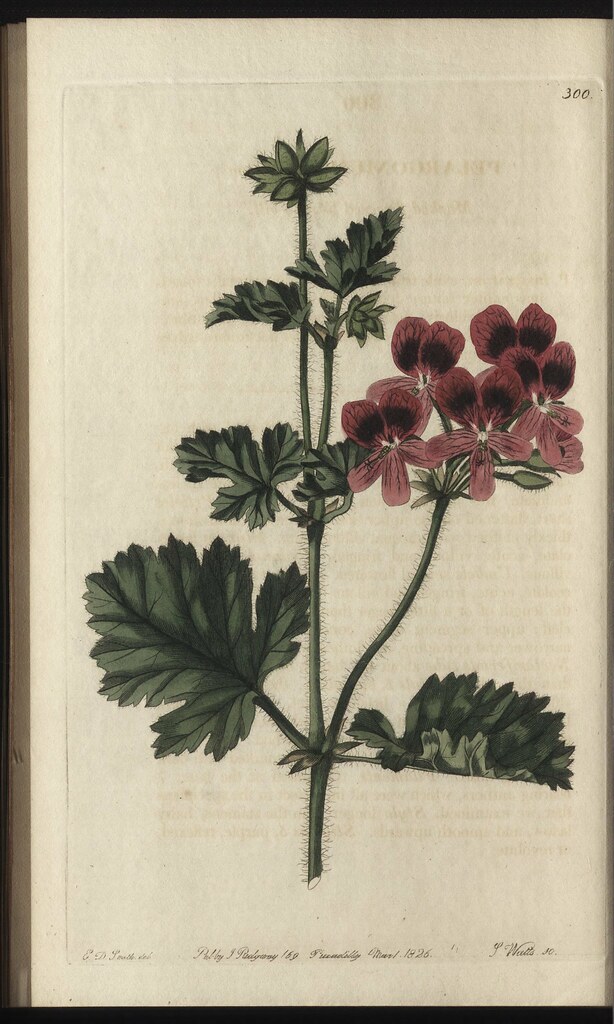#pictorial mark
Text


Shelter House (Type B)
Need logo design? 👉 hire us
#logo#design#logo design#branding#icon#smart logo#pictorial mark#art#illustration#big#shop#shopping#minimalist logo#minimal logo#modern logo#logos#logo type#graphic design
2 notes
·
View notes
Text

EGA logo
#logo#design#logo design#branding#icon#smart logo#pictorial mark#art#illustration#big#shop#shopping#minimalist logo#minimal logo#modern logo#logos#logo type#graphic design
3 notes
·
View notes
Text
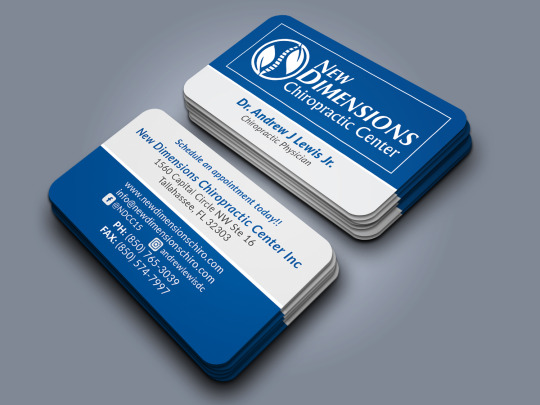
Hey, Need a logo design? 👉 hire us
#logo design#logo#design#negative space#negative space logo#h#monogram#pictorial mark#letterform#letter mark#brush#paint#modern logo#minimalist logo#smart logo#businesscards#businesscard
0 notes
Text



#so proud of u mark 🤎 our prl ambassador 🤎 this pictorial suits him soooo well 🤎 excited for the goods#minhyung#nct
63 notes
·
View notes
Video
n370_w1150 by Biodiversity Heritage Library
Via Flickr:
The natural history of Carolina, Florida, and the Bahama Islands :. London :Printed for B. White,1771.. biodiversitylibrary.org/page/38993718
#Botany#Natural history#North Carolina#Pictorial works#Pre-Linnean works#Southern States#University Library#bhl:page=38993718#dc:identifier=http://biodiversitylibrary.org/page/38993718#artist:viaf=47612282#Georgia#Florida#South Carolina#plants#flowers#mammalogy#zoology#mammals#BHLCatesby#mark catesby#bison bison#buffalo#rose locust#robinia hispida#bristly locust#moss locust
2 notes
·
View notes
Link
Logos are an important part of establishing a brand and its marketing. All the Logo and its types are based on combination of representative image and typography skills. Therefore, you should make your logo the best because it is the first thing customers notice. All the logos and its types are equally important and impactful.
0 notes
Text

Bruce Sargeant in his studio with model (c.1930) by Mark Beard
Mark Beard has become famous thanks to the creation of several fictional characters, each with a detailed biography that marks his own pictorial style, which allows him to recreate different styles, from nineteenth-century expressionism to post-modern art. His paintings and bronzes have been exhibited all over the world. He is a very skilled and versatile artist, working not only with different styles, but also with different media: bronze sculpture, ceramics, oil painting, drawing or architectural models. Bruce Sargeant is one of those fictional characters.
363 notes
·
View notes
Text
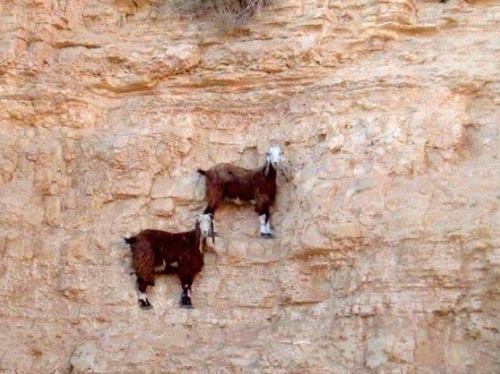
How on earth did these goats get there?
*****
In reality the goats are lying on their sides on rocky ground, looking up at a crane-mounted camera. The photograph was taken some years ago, part of a series reconstructing Central European folk customs and traditions which have fallen from favour or are now prohibited.
This old-fashioned rural blood-sport was originally practiced in parts of Anatolia, Turkey, where the game was called keçi fırlatmak, and also in the Carpathian Alps of Romania, possibly imported during the Ottoman conquest. The name there was aruncarea caprei.
*****
The goats would have been coated in a strong adhesive traditionally distilled from pine resin.(represented pictorially here by darker patches of dye on the flanks) and were then thrown upwards towards a cliff or rock-face with makeshift catapults, often a primitive form of counterweight trebuchet assembled from wooden beams and weighted with rocks.
The game ended when the glue dried and lost adhesion, and the goats fell to their deaths. They were then cooked and eaten, their meat being valued like that of Spanish fighting bulls.
The meat of the last goat to fall (başarılı keçi or cea mai durabilă capră) was prized as a special delicacy and selected cuts from the legs of this particular “winner” goat were often smoked and dried into a kind of jerky.
*****
In his “Grandes Histoires Vraies d'un Voyageur le 1er Avril” (pub. Mensonges & Faussetés, Paris, 1871) French folk-historian, anthropologist and retired cavalry general Gilles-Etienne Gérârd wrote about witnessing a festival near Sighișoara, Transylvania, in 1868.
There he claims to have seen catapults improvised from jeunes arbres, très élastiques et souples - “very springy and flexible young trees” - which were drawn back with ropes and then released.
Bets were placed before the throw, and marks given afterwards, according to what way up the goats adhered and for how long. The reconstruction, with both goats upright, facing outward and still in place, shows what would have been a potential high score.
The practice has been officially banned in both countries since the late 1940s, but supposedly still occurred in more isolated areas up to the end of the 20th century. Wooden beams from which the catapults were constructed could easily be disguised as barn-rafters etc., and of course flexible trees were, and are, just trees.
*****
Gérârd’s book incorrectly calls the goat jerky “pastrami”, to which he gives the meaning "meat of preservation".
While pastrami may be a printing error for the Turkish word bastırma or the Romanian pastramă, both meaning “preserved meat”, at least one reviewer claims that Gérârd misunderstood his guide-translator, who would have been working from rural dialect to formal Romanian to scholarly French.
Since this jerky was considered a good-luck food for shepherds, mountaineers, steeplejacks and others whose work involved a risk of falling, Gérârd's assumption seems a reasonable one.
However, several critical comments on that review have dismissed its conclusion, claiming "no translator could be so clumsy", but in its defence, other comments point out confusion between slang usage in the same language.
One cites American and British English, noting that even before differences in spelling (tire / tyre, kerb / curb etc.) "guns" can mean biceps or firearms, "flat" can mean a deflated wheel or a place to live, "ass" can mean buttocks or donkey and adds, with undisguised relish, some of the more embarrassing examples.
This comment concludes that since the errors "usually make sense in context", Gérârd's misapprehension is entitled to the same respect.
*****
The good-luck aspect of the meat apparently extended to work which involved "falling safely", since its last known use was believed to be in ration packs issued to the 1. Hava İndirme Tugayı (1st Airborne Brigade) of the Turkish Army, immediately before the invasion of Cyprus in July 1974.
Nothing more recent has been officially recorded, because the presence of cameras near military bases or possible - and of course illegal - contests is strongly (sometimes forcefully) discouraged, and the sport’s very existence is increasingly dismissed as an urban or more correctly rural legend.
The official line taken by both Anatolian and Carpathian authorities is that it was only ever a joke played on tourists, similar to the Australian “Drop-bear”, the Scottish “Wild Haggis” and the North American “Jackalope”.
They dismiss the evidence of Gérârd’s personal observation as “a wild fable to encourage sales of his book”, “a city-dweller’s misinterpretation of country practices”, or even “the deliberate deception of a gullible foreigner by humorous peasants”.
And as for those paratroop ration packs, Turkish involvement in Cyprus is still such a delicate subject that the standard response remains “no comment”.
82 notes
·
View notes
Text

Willem de Kooning
Woman in a Landscape, 1965
oil on vellum mounted to card on board 60.3 x 47.9 cm
The Willem de Kooning Foundation Artists Rights Society (ARS), New York
"Bill de Kooning contrasts the distorted fragments of a woman and fuses them with his sense of the pictorial."
- Mark Rothko
165 notes
·
View notes
Text

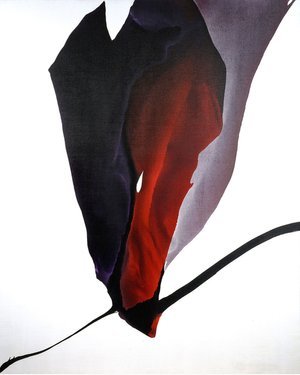




Paul Jenkins (1923-2012)
Born and raised in Kansas City, Missouri, Paul Jenkins’ interest in art began with frequent visits to the Nelson-Atkins Museum of Art where he was drawn to its Asian art collection. While a high school student, Jenkins experienced the chemistry of painting working summers in a ceramics factory. Watching expert artisans at work, Jenkins witnessed the tension in timing the correct moment to add something in an artistic creation. After serving in World War II, Jenkins used his military service benefit to attend the Art Students League in New York from 1948 to 1952. Jenkins’ four year course at the League occurred during the advent of Abstract Expressionism, a style which saw painting not as a recording of an object or place but as an emotional event. Meeting Jackson Pollock, Mark Rothko, and Barnett Newman, Jenkins realized his own artistic goal was to transform intangible feeling into valid pictorial forms. He saw that Pollock did this in woven webs of paint while Rothko achieved it using tonal fields of color as containers of light. Jenkins noted that both Pollock and Rothko achieved structure while leaving no trace of brushstrokes. In becoming an Abstract Expressionist, Jenkins discarded deeper perspective, recognizable subject matter, a contained composition, and standard brush use. Perhaps remembering the glazes melting, flowing, and interacting in the kiln at the ceramics factory helped Jenkins discover his unique painting technique.
51 notes
·
View notes
Text

Shelter House TYPE A.
Need logo design? 👉 hire us
#logo#design#logo design#branding#icon#smart logo#pictorial mark#art#illustration#big#shop#shopping#minimalist logo#minimal logo#modern logo#logos#logo type#graphic design
2 notes
·
View notes
Text

#logo#design#logo design#branding#icon#smart logo#pictorial mark#art#illustration#big#shop#shopping#minimalist logo#minimal logo#modern logo#logos#logo type#graphic design
1 note
·
View note
Text
#logo design#logo#design#negative space#negative space logo#h#monogram#pictorial mark#letterform#letter mark#brush#paint#modern logo#minimalist logo#smart logo#businesscards#businesscard
0 notes
Text
Black Ships
The Black Ships ( 黒船, romanized: kurofune, Edo period term) was the name given to Western vessels arriving in Japan in the 16th and 19th centuries.
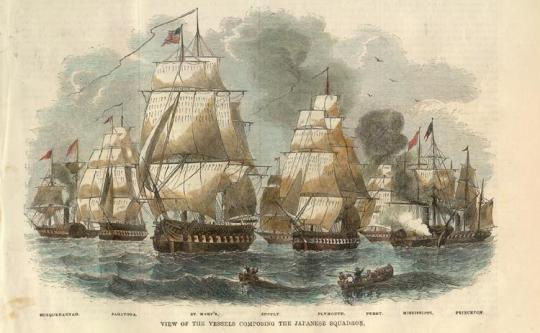
Commodore Perry's fleet for his second visit to Japan in 1854 - Engraving from Gleason’s Pictorial Drawing-Room Companion, Boston, May 15, 1852, Volume II, No. 20, page 305
In 1543, Portuguese initiated the first contacts, establishing a trade route linking Goa to Nagasaki. The large carracks engaged in this trade had the hull painted black with pitch, and the term came to represent all Western vessels. In 1639, after suppressing a rebellion blamed on the influence of Christian thought, the ruling Tokugawa shogunate retreated into an isolationist policy, the Sakoku. During this "locked state", contact with Japan by Westerners was restricted to Dutch traders on Dejima island at Nagasaki.
In 1844, William II of the Netherlands urged Japan to open also the mainland to trade, but was rejected. On 8 July, 1853, the U.S. Navy sent four warships into the bay at Edo and threatened to attack if Japan did not begin trade with the West. The ships were Mississippi, Plymouth, Saratoga, and Susquehanna of the Expedition for the opening of Japan, under the command of Commodore Matthew Perry. The expedition arrived on 14 July, 1853 at Uraga Harbor (present-day Yokosuka) in Kanagawa Prefecture, Japan. Though their hulls were not black, their coal-fired steam engines belched black smoke.
Their arrival marked the reopening of the country to political dialogue after more than two hundred years of self-imposed isolation. Trade with Western nations followed five years later with the Treaty of Amity and Commerce. After this, the kurofune became a symbol of the end of isolation.
#naval history#black ships#short overview#before i get the asks what they are#western vessels#japan#16th-19th century#more about perry soon#age of sail#age of discovery#history
62 notes
·
View notes
Video
n407_w1150 by Biodiversity Heritage Library
Via Flickr:
Geraniaceae : London :Printed for James Ridgway, Piccadilly,1820-1830. biodiversitylibrary.org/page/47410194
#19th century#England#Engravings#Geraniaceae#Geraniums#Great Britain#Hand coloring#Pictorial works#Research Library#The Getty Research Institute (archive.org)#bhl:page=47410194#dc:identifier=https://biodiversitylibrary.org/page/47410194#marked-flowered stork's-bill#pelargonium insignitum#Pelargonium × insignitum Sweet#Pelargonium × insignitum#Pelargonium#botanical illustration#scientific illustration#cottagecore#flowercore
1 note
·
View note
Note
I see you very much as an expert on all things Rohirrim, so I bring to you this question, hoping I can pick your brain for info to use in my own fics (full disclosure). 😅
It seems to be a popular fanon that the Rohirrim/Riders of Rohan have tattoos, and that body art is a part of their culture. Do you have any thoughts or personal HCs about this that you're willing to share?
Thank you in advance! I appreciate you and your blog so much (if you didn't already know that).
Oh my goodness!!! I am so very honored to be thought of as a person who is knowledgeable about my beloved Rohirrim, and I hope very much that I can live up to that reputation. Thank you!!!
I’m not aware of any real textual evidence for body art among the Rohirrim, and the historical record in the medieval Anglo Saxon and Norse societies that Tolkien used as a reference for them seems to be disputed. But I absolutely understand and agree with the conventional wisdom that tattoos are a thing in Rohan. It just fits well with a warrior culture that has a wilder, dare-I-say more pagan aesthetic as compared to the smooth solemnity of Gondor or the formal elegance of the elves. And since they’re a culture that doesn’t document things in written words, pictorial representations such as tattoos and body art would be one way to fill that gap (along with their songs and oral traditions).
In my mind, tattoos in Rohan are common but basic—they’ve really only got the technology for the “stick and poke” method so the designs are kept simple because anything too elaborate is difficult to pull off well. They’re mostly in black line (using soot) but some have color using powder made from grinding up certain dried roots and plants.
Each village/community has its own distinctive tattoo motif that is worn by all of that community’s members. So you can tell just by looking at someone whether they’re from Upbourn (a fish because it’s a river town) or Dunharrow (mountain peaks since they’re in the White Mountains) or Everholt (a boar in honor of the wild boar that live in this part of the Firien Wood), etc. And soldiers also tend to share tattoo designs specific to their éored—getting your éored’s mark is a formal rite of passage for the younger members when they first get assigned to their company. These shared tattoo designs are important both for group cohesion and as a means of identifying fallen Rohirrim even if the deceased isn’t known to whoever finds the body.
Beyond these ritualized and practical functions, I do also like to think that there are some purely decorative tattoos among them as a means of personal expression and/or to help cover small scars that so many Rohirrim have from battle, riding accidents or other mishaps. Obviously horse-based designs would be very popular, as well as other flora and fauna of Rohan. But they’re a very sentimental people and so I think little emotional signifiers would also be very common (again, especially because they generally don’t have a means to pay tribute to beloved people/things in written form, this sort of symbol would serve the purpose of making some kind of record of those tributes).
In terms of specific people in my head canon: Éomer has a little simbelmynë blossom for each of the major figures in his life that he’s lost (forearm). Háma had a sun to remind him of his wife, who brought warmth and light to his life (shoulder). Théodred had stars in the shape of a particular constellation that is visible every year on his mother’s birthday (chest). Éowyn has a representation of her father’s sword (left wrist) and gets a quill (right wrist) to represent Faramir after they get married. (Faramir got a little running horse in her honor on his first trip to Rohan. He was glad he did it, but he never wants to sit through that again.)
Merry brought tattooing back to the Shire when he showed up with a tobacco pipe on his bicep (both for its association with Buckland and in tribute to Théoden, whose last words to Merry were about smoking together someday when peace was restored). Unsurprisingly, tattoos did not catch on with the other hobbits, but Merry remains very proud of it.
Anywayyyy…I hope that was in any way helpful! Thanks so much for asking!! I remain a huge fan and am so grateful to you for helping convince me to put some of my thoughts and stories out there vs keeping them all in the confines of my own Google drive!
#lord of the rings#lotr#tolkien#asks#answered asks#rohan#rohirrim#éomer#éowyn#háma#théodred#merry#faramir#lotr headcanon#tattoos
55 notes
·
View notes
